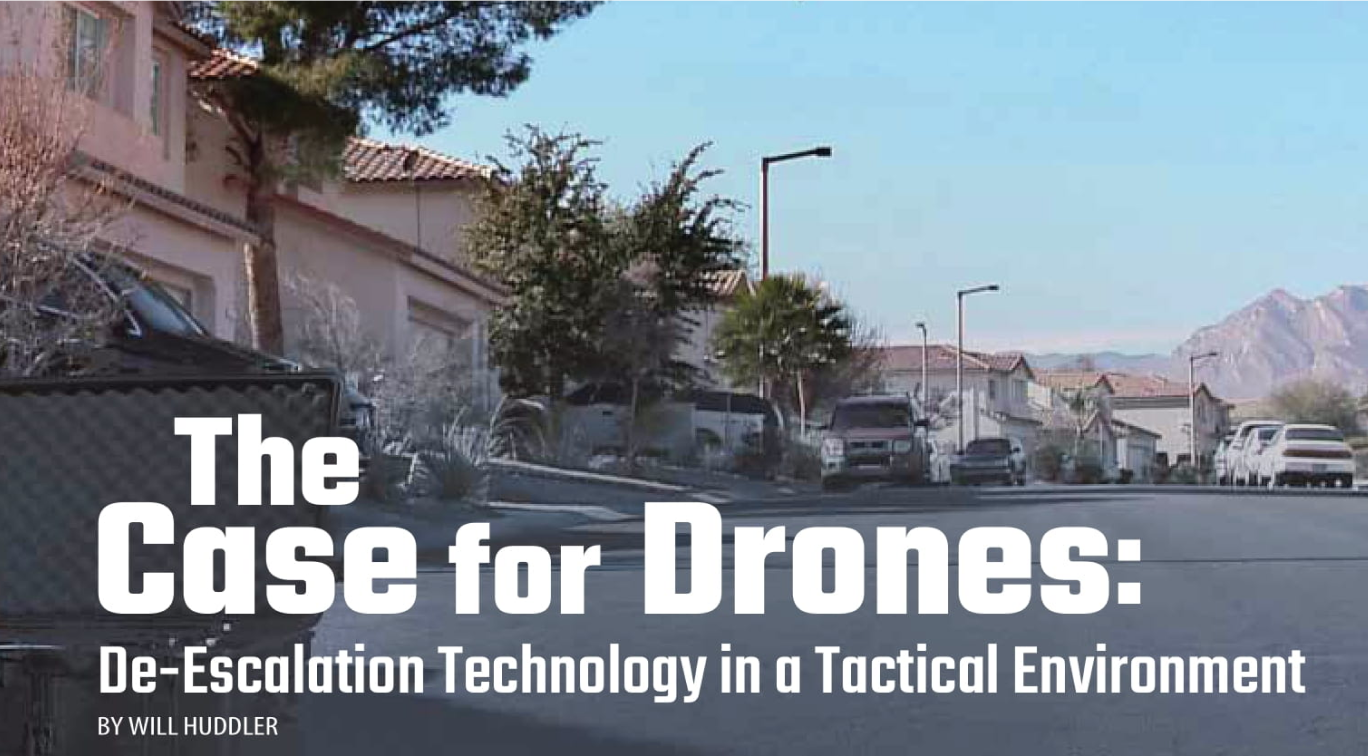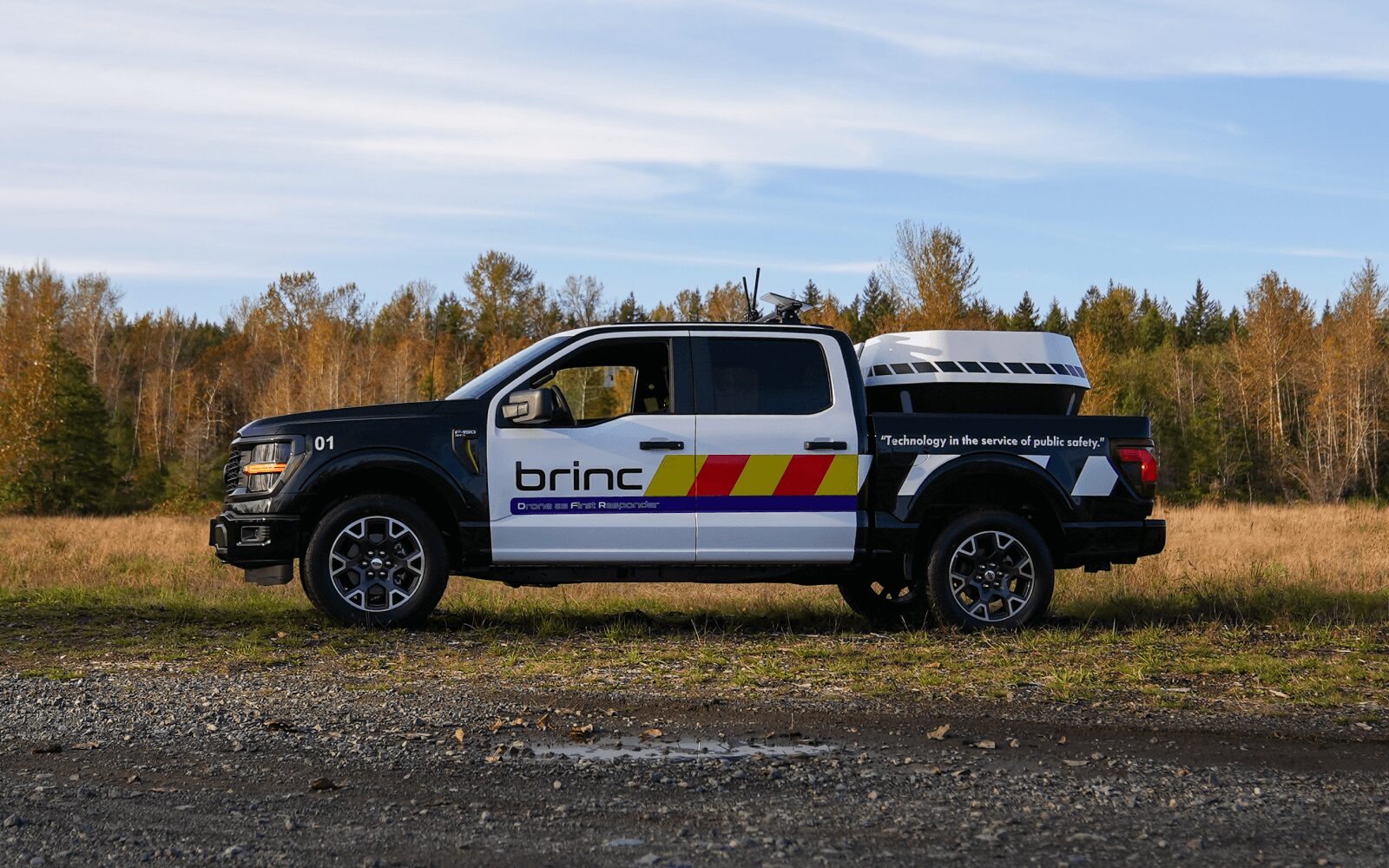
The Case for Drones: De-Escalation Technology in a Tactical Environment
Wanted for murder, kidnapping and sexual assault, the barricaded suspect fires multiple rounds through the front door as unwary detectives conducted follow-up. The tactical team responds in the ultimate de-escalation attempt. The sus- pect, lying in wait within a second-floor apartment, fortifies his position. Hours into the barricade, the team loses com- munication with the suspect. He now begins to fire rounds arbitrarily out of an elevated bathroom window toward the city skyline. Traditional negotiation options all fail. The rounds continue to fly through the window and sail toward a soon-to-be very busy area of town. Hundreds of citizens
are evacuated as the operation enters its 14th hour.
This hypothetical operation represents the challenges tactical commanders and their agencies face as they ensure the exhaustion of every viable option in a critical incident. This is the perpetual tactical team dilemma, represented by the constant pursuit of preclusion through de-escalation. De-escalation isn’t just a catchphrase used to satiate critics of police use of force. The term represents a worldview that prioritizes the sanctity of life.
De-escalation, as an underlying tactical philosophy, informs strategy and guides decision-making. Perhaps the most important tenet of this philosophy is that of preclusion. That is, one simple but crucial analysis: “Has every reasonable option been exhaust- ed before authorizing a tactical team to confront an armed and dangerous assailant?” This confrontation, which occurs in thousands of cities every day across this nation, can result in police use of force and injury to both officers and citi- zens.1 These outcomes, which have played out in the national spotlight, can either add another brick to the wall of public trust or bring a city to its knees with riots and civil unrest.
DE-ESCALATION TECHNOLOGY
Tactical teams are no stranger to testing and evaluating the latest technology — not for the sole purpose of breaking some poor vendor’s hardware, but because any operator, team leader or commander is hoping to find a new tool or tactic to improve overall operational safety. This is done in an effort to ensure every life that walks into an operation, walks out.
Terrestrial robotic platforms are the current default option for interior remote search and communication. Al- though these tools have their place in a team’s arsenal, they are not without their operational limitations. Specifically, terrestrial robotic platforms can struggle to add value to efficiency and practicality. Additionally, connectivity chal- lenges associated with these traditional platforms sadly have become the norm on operations.
ENTER THE DRONE
Currently, unmanned aerial systems (UAS or drones) are not deployed into structures to a high degree. Rather, they are used to assess the exteriors of structures or assist with overhead aerial imaging. However, UAS can be more versa- tile than they are given credit for, and ought to be considered by SWAT commanders as a preclusion tool to be deployed inside a structure.
The right UAS platform can allow for efficient remote access and assist with the location of and communication with armed and dangerous assailants. Emerging, highly accessible technology now allows for access to drone-mount- ed, high-definition, encrypted video and sound feeds that simultaneously reach a tactical operation center, team leaders, and incident command posts. The data can then be uploaded for evidentiary value and training application.
An operator positioned safely behind cover one block away can use the right UAS platform to break a structural window and maneuver through that access point. Specific UAS platforms can be used to push through partially open interior doors, allowing for visual access and communication. A UAS can even be used to place communication devices throughout a structure. Finally, specific UAS platforms can be perched within a structure for hours of visual access and two-way communications to aid in crisis negotiations and de-escala- tion efforts.
UAS PROGRAMS FOR TACTICAL TEAMS
The following areas of concern should be addressed when testing and evaluating specific UAS technology:
Program implementation and legal considerations: Under the Federal Aviation Administration’s (FAA) UA rule, tactical teams and/or agency leadership can choose to have Part 107 UAS pilots trained and licensed, or, under the FAA’s Public Aircraft Operator provision, team leadership can secure a Certificate of Authorization (COA) with the FAA, which can take up to 60 days. This allows for a single Part 107 pilot to serve as program manager, training/certify- ing respective COA pilots.
Under each of these options, a tactical team can operate a tactical UAS under the FAA’s provision for Emergency Authorizations and Operations for law enforcement, search and rescue, fire, etc.
All of these operations can take place as a provision for emergency public safety operations under the Special Gov- ernment Interest (SGI) amendment process outlined in FAA Order JO 7200.23A. In terms of local stakeholders, crafting a UAS provision into an agency’s search warrant templates by working with the local prosecutor’s office is a key compo- nent to program success.
De-escalation isn’t just a catchphrase used to satiate critics of police use of force. The term represents a worldview that prioritizes the sanctity of life.
Policy and training: Consistent with sound training doctrine, constructing specific policy on UAS deployment, then training officers to carry out the new specialized SOP or policy2 represents best practice. Legitimate UAS vendors who understand the operational demands and liabilities of public safety, will offer initial training and/or certification blocks
to support efficient technology implementation, and thereby support program success. Additionally, a computer-based simulator wherein a UAS pilot can log flight hours is suffi- cient when preparing to operate the UAS in training and then tactical operations.
Durability: A broken drone is an ineffective drone. An effective assessment must include evidence that a specific platform can withstand the rigors of tactical operations and SWAT team use. Additionally, because of the unpredictabili- ty of structural layouts and obstacles, durable airframes and self-righting piloting features are highly desirable.
Legitimate UAS vendors will offer warranty/replacement options and will have the ability to ship out a replacement unit to a team on short notice. They may even field support calls 24/7 to support program success.
Connectivity: This is a crucial component in the success of any tactical UAS program. The ability to stream data with low latency is crucial in rescue operations. This must be a priority when testing and evaluating UAS platforms to ensure compatibility with your tactical team’s information technology infrastructure. A legitimate UAS vendor will offer options to tactical teams and demonstrate agility to ensure successful program implementation.
TECHNOLOGY
Piloting technology: The right platform will not be en- cumbered by GPS technology to optimize interior applica- tion, thereby ensuring another layer of operational security, as this will make the UAS less susceptible to security threats. Additionally, the absence of GPS will allow for the UAS platform to maneuver through tight interior spaces. The downside of this, however, is that the absence of GPS can create greater need for piloting skill. That said, specific
UAS platforms can be equipped with additional pilot-assist technology for ease of flight.
Modularity: In the world of emerging technology, modu-larity is king. Therefore, an effective UAS platform will avail modular attachments to enable performance on a broad range of missions. Current attachments available to tactical drones include glass breakers, payload droppers, enhanced flood lighting, pan-tilt-zoom cameras, infrared and night vision capabilities, to name a few.
OPERATIONS
UAS introduction into a tactical operation should not be limited to barricades. Teams around the country are moving away from “going fast” on search warrants for many reasons. Although dynamic entries on search warrants are a valuable tool when necessary, slow and methodical or breach and hold services tend to rule the day. Utilizing large terrestrial robots on search warrants is not the operational norm around the country due to several reasons, including the time this tactic adds to a search warrant service. Teams often resort to handheld robotic platforms to provide lim- ited visual access into a structure. If a handheld platform is warranted, then the right UAS platform may be preferable.
PROGRAM FUNDING AND POLITICS
Though the tactical UAS market is limited, platforms exist that range in price from $500 for the flimsiest of platforms, up to $100,000 for drones equipped with facial recognition. That said, a team can find a legitimate UAS platform to fulfill tactical needs for less than the cost of a conventional handheld robotic platform. Not unlike the
A team can find a legitimate UAS platform to fulfill tactical needs for less than the cost of a conventional handheld robotic platform. Not unlike the purchase of any other tactical team equipment, leaders must justify compelling need, and depending on their jurisdiction’s purchasing/procurement processes and political climate, it may be difficult to implement a UAS program.
purchase of any other tactical team equipment, leaders must justify compelling need, and depending on their jurisdiction’s purchasing/procurement processes and political climate, it may be difficult to implement a UAS program. That is why teams around the country have procured tactical UAS platforms with use of private funds via charitable founda- tions, grant funding, internal budget reallocation, and seizure funds, to name a few methods. Because of this, an important factor to consider is whether or not a UAS vendor is willing to customize purchasing options to fit an agency’s needs. Some UAS vendors will demonstrate flexibility as it relates to offering purchase options.
Consider current legislation when justifying a UAS pur- chase to stakeholders, specifically, the appetite to move away from militarizing tactical teams. This notion is worrisome, but it creates an opportunity for agencies to bargain for a UAS with two-way communication. This way, the UAS is a legitimate crisis-negotiation tool, rather than a weaponized drone. Additionally, finding a UAS platform that is built in the United States will assist in procuring grant funds encum- bered by strict security concerns. No matter the procurement method, the responsibility of implementing proven emerging technology falls squarely on the shoulders of leadership.
CONCLUSION
Sound tactical philosophy dictates preclusion be exer- cised before introducing a team into a structure or closing distance on an armed assailant. The right UAS can accom-plish this and save lives in the process. New and emerging technology being utilized throughout policing is changing the way agencies police their respective communities.3 Applying this approach and advancing a tactical team’s capabilities associated with remotely searching and communicating with a UAS is the next reasonable and perhaps necessary step in advancing not only tactical operations, but perhaps all of public safety operations.
ABOUT THE AUTHOR
Lt. Will Huddler is an 18-year law enforcement veteran at a large metropolitan police agency in the southwest United States. He has led the investigations of over 30 officer-involved shootings and in-custody deaths. He has experience as the SWAT tactical commander over one of the busiest teams in the country and serves on the Board of Directors of the Society for Integrity of Force Investi- gation and Reporting (SIFIR). Lt. Huddler instructs various POST supervisory and management leadership courses and owns and operates Civic Ops LLC, which serves as a public safety and technology consulting firm.


